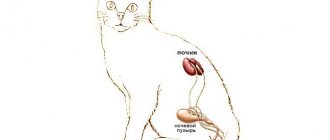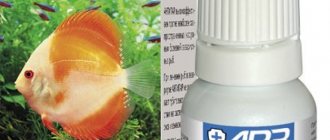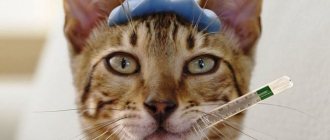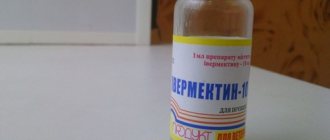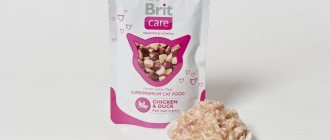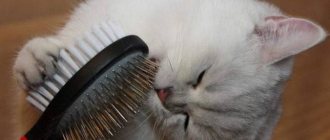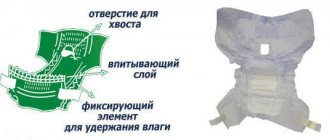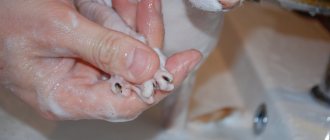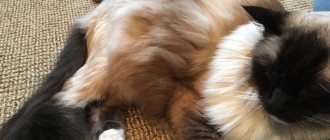Composition and release form
The anti-inflammatory drug is available in the form of an injection solution. The transparent liquid may be colorless or have a light yellow tint. For packaging, bottles made of clear or dark glass are used. Pharmacies offer bottles of various sizes, but for cats it is worth buying small bottles of 5 or 10 m, since the dose is calculated taking into account the weight of the animal.
The main active ingredient is ketoprofen. Its concentration in the medicinal solution can be 2.5%, 5% and 10%. The composition also includes the following components:
- water for injections;
- benzyl alcohol;
- lemon acid.
They perform an auxiliary function, for example, citric acid improves the absorption of ketoprofen.
There are no special requirements for storing the medication, although the bottle should be in a dry place protected from ultraviolet rays. The temperature should be between 5 and 25 degrees Celsius.
Note! When storing the drug at low temperatures (about 5 degrees), crystals may appear at the bottom, which dissolve on their own when the liquid is heated. This phenomenon does not affect the properties of the drug in any way.
Analogues of Flexoprofen
Flexoprofen is a fairly common drug, sold at an affordable price (288 rubles for a solution of 2.5% 10 ml). But sometimes it is not available in pharmacies - then the product can be replaced with drugs of a similar effect.
Table: comparison of drugs with similar effects to Flexoprofen
| Name | Main active ingredient | Release form | Difference from Flexoprofen | approximate price |
| Ainil (Spain) | Ketoprofen 1 or 10% | Injection | Complete analogue of Flexoprofen. There is an option on sale with a 1% concentration of ketoprofen, which is convenient for treating small animals (including kittens). |
|
| Ketoquin (Russia) | Ketoprofen 1 or 10% | Injection | Available in a convenient concentration of 1% for treating small animals. An additional component in the composition - L-arginine - helps improve the regeneration of cartilage tissue and the composition of the interarticular fluid. |
|
| Loxicom (UK) | Meloxicam 0.05 and 0.15% | Suspension for oral administration | The oral method is more complicated than the injection method. Loxicom acts more slowly than Flexoprofen (due to the fact that the maximum concentration in plasma occurs after 4-6 hours). |
|
| Onsior (UK) | Robenacoxib 5, 6, 10, 20 mg | Pills | Due to the tablet form of the product, it is difficult to accurately calculate the dosage. The medicine is prohibited for animals weighing less than 2.5 kg. |
|
Photo gallery: Flexoprofen analogues
Ainil is a non-steroidal anti-inflammatory drug that has anti-inflammatory, analgesic and antipyretic effects.
Contraindications to the use of Ketoquin are individual hypersensitivity of the animal to the components of the drug, stomach and duodenal ulcers
Loxicom is an analgesic drug in the form of a suspension, which belongs to the group of non-steroidal drugs.
Onsior contains robenacoxib as an active ingredient
How it works
Flexoprofen has the following properties:
- eliminates pain;
- relieves inflammation;
- reduces swelling;
- has an antipyretic effect.
The effect of the drug is determined by ketoprofen. The principle of its action is that when it enters the body, the active component blocks the production of substances that are involved in inflammatory processes, accompanied by pain, swelling, and redness.
The advantage of Flexoprofen is its rapid action. Just 30 minutes after injection, the concentration of ketoprofen in the blood reaches its maximum value. Since the drug is distributed throughout the body along with the bloodstream, it works effectively regardless of the location of pain. The animal body absorbs from 85 to 100% of the drug. The components of the drug are excreted from the body mostly through the kidneys.
Security measures
If injections are made with Flexoprofen, you should adhere to the general rules for working with veterinary drugs:
- After contact with the medicine, be sure to wash your hands.
- People with hypersensitivity and a tendency to allergic reactions should be extremely careful and it is advisable to avoid direct contact with the medication. To do this, you should use rubber gloves.
- If the drug gets into your eyes or skin, rinse them with running water.
- If allergies occur, seek help from a doctor.
Using empty bottles in everyday life for any purpose is strictly prohibited. They must be recycled.
Indications for use
The drug is effectively used in the treatment of chronic and acute pathologies. Indications for the use of Flexoprofen for cats according to the instructions are:
- arthritis, arthrosis and other diseases of the musculoskeletal system;
- fractures, dislocations and other injuries;
- acute colic;
- pathologies that are accompanied by an increase in body temperature.
Also, the medicine is often prescribed in the postoperative period to reduce pain and prevent swelling.
Note! The medicine is used to eliminate unpleasant symptoms (pain, swelling, increased body temperature), but it is not able to cope with the cause of the disease, so it is used only in complex therapy.
Purpose
Veterinarians prescribe Flexoprofen for cats with the following pathologies of the musculoskeletal system:
- osteoarthritis;
- spondyloarthrosis;
- rheumatoid and gouty arthritis;
- dislocations;
- bruises;
- fractures;
- herniated intervertebral discs;
- extra-articular rheumatism (capsulitis, bursitis);
- synovitis;
- tenosynovitis;
- traumatic pain.
In addition, the medicine is used for acute attacks of colic, elevated body temperature, and in postoperative therapy to reduce tissue swelling and eliminate pain syndromes. Flexoprofen is used in complex treatment to relieve symptoms of the disease (fever, swelling, pain), but it does not treat the causes themselves.
How to use
Typically, Flexoprofen is administered to cats intramuscularly or subcutaneously. For acute pain or extreme fever, it is recommended to give intravenous injections so that the medicine begins to work faster.
The dose is calculated based on the pet's weight, so you need to weigh it first. For every kilogram of weight you need 2 mg of the active substance. The amount of solution depends on its concentration. Typically 2.5% Flexoprofen is used for cats. 1 ml of this solution contains 25 mg of ketoprofen, that is, it is designed for 12.5 kg. To avoid overdose, entrust the calculation of the dose for your cat to your veterinarian.
Injections should be given once a day. The course of treatment can last from 1 to 5 days. It is not recommended to use the medicine for more than 5 days due to the risk of side effects. You should avoid missing the next injection, as this may affect the effectiveness of the drug. If the injection could not be given on time for some reason, you need to return to treatment as soon as possible. There is no need to increase the dose.
Dosage
Flexoprofen can be administered to a cat intravenously, intramuscularly or subcutaneously. Typically, intravenous injections are made in a veterinary clinic at a high temperature, this allows you to quickly relieve the symptom, since the drug begins to act much faster than with other types of drug administration. At home, Flexoprofen is injected subcutaneously into the withers or intramuscularly into the thigh at an angle of 90 degrees.
The duration of treatment is prescribed by the veterinarian, taking into account the diagnosis and condition of the cat, and he also determines the dosage of the drug. Before prescribing the dose, it is necessary to weigh the cat, since the amount of solution administered depends on the weight of the animal.
The dose is calculated based on the cat's weight. If the pet weighs 5 kg, then the active substance per injection requires 10 mg, or 0.2 ml of Flexoprofen solution. The drug is administered once a day. Treatment lasts from 1 to 5 days. Continued use of the drug may cause side effects, as well as an incorrectly calculated dosage. It is not recommended to interrupt the course of treatment, as this will reduce the effectiveness of therapy.
Important points
When using Flexoprofen to treat cats, the following should be considered:
- The anesthetic should not be combined with the use of other non-steroidal anti-inflammatory drugs to avoid overdose.
- It is not recommended to use the medicine together with anticoagulants (drugs that thin the blood), glucocorticoids and laxatives.
- Do not mix an anti-inflammatory drug with other medications in the same syringe.
- When administering a medicinal solution, you must follow the rules of antiseptics. For injections, use disposable syringes or sterile needles that have been boiled for 15 minutes.
Flexoprofen can have a negative effect on the digestive system and cause bleeding, so its use is often combined with Ranitidine or other similar medications.
When working with the drug, you need to follow simple safety precautions. After the procedure, wash your hands with soap and running water. Medicine bottles must be disposed of; using them for domestic purposes is strictly prohibited. If you are hypersensitive, you should use rubber or latex gloves to avoid direct contact with the solution, which can cause a rash or other allergic reactions.
special instructions
Special conditions for using this drug are as follows:
- When administering an injection to an animal, it is important to follow personal hygiene instructions and safety precautions for working with medications. Eating food, liquids, and smoking are strictly prohibited during this time! At the end of the procedure, be sure to wash your hands with soap.
- If the solution gets on your skin or mucous membranes, wash them with plenty of water. If strange reactions occur, especially if you are hypersensitive to at least one of the components of the drug, you should contact a medical facility as soon as possible.
- Do not use bottles of the product for household purposes.
- Do not allow children to have access to the medicine.
"Flexoprofen", which also has more expensive analogues, is an excellent remedy with few contraindications, and has little danger in case of overdose. And, as we have seen, it has a wide range of indications for use, suitable not only for cats and dogs, but also for a number of other animals.
When not to use
According to the instructions, Flexoprofen for cats cannot be used in the following cases:
- when bearing offspring (regardless of the period);
- with liver failure;
- with renal failure;
- for problems with blood clotting;
- with bleeding;
- with stomach or duodenal ulcers.
You should also avoid using the drug if you are intolerant to the active substance or other components. For chronic pathologies of the liver and kidneys, it is necessary to consult a doctor before use. In this case, it is recommended to constantly monitor the performance of these organs.
The anesthetic is usually well tolerated by animals and does not cause side effects. In case of intolerance to the components, allergic reactions occur. In this case, further treatment with an anti-inflammatory drug is stopped and anti-allergy medications and drugs are prescribed to relieve the symptoms that appear.
In case of overdose, the following side effects may occur:
- nausea;
- vomit;
- stomach upset;
- loss of appetite;
- refusal of food;
- weakness.
If such symptoms appear, stop taking Flexoprofen. If the animal's condition does not improve, you should consult a doctor.
Possible side effects and contraindications
When treating with Flexoprofen, the following types of adverse reactions may occur:
- From the gastrointestinal tract: diarrhea;
- mild nausea;
- belching;
- flatulence;
- dry mouth (causing the animal to drink frequently).
- weakness;
If side effects are mild, you should not stop injecting the drug, especially since the course is short-lived. If the symptoms are severe, you should consult a veterinarian - the doctor will examine the patient and, if necessary, select another medicine.
Strict contraindications for the use of Flexoprofen are:
- hypersensitivity to the components of the drug;
- stomach and duodenal ulcers;
- disorders of the blood coagulation system;
- pathologies of the kidneys and liver.
Owner reviews
Victoria, owner of a British cat:
“When our cat caught the infection (she had feline distemper), she developed a very high temperature. To relieve fever, the doctor prescribed Flexoprofen. One injection was enough for the temperature to return to normal and not rise again. There were no side effects, Muska tolerated the medicine well.”
Vadim, owner of a 10-year-old cat:
“Older animals often have joint problems. They didn't spare our 10-year-old cat either. Arthritis was accompanied by severe pain. The joints were swollen. The cat refused to even walk around the house. On the advice of a doctor, Flexoprofen injections were used to eliminate these symptoms. A week later, the cat began to run again, and the pain stopped bothering him. It’s a good medicine, but after a while the symptoms return, so we repeat the course every 2-3 months.”
Svetlana, owner of a Persian cat:
“When we treated our cat for uveitis, Flexoprofen was also included in the complex therapy. The drug saved the animal from suffering. Even after stopping treatment, the pain did not return. It’s a good drug, but you shouldn’t use it for self-medication because of the risk of aggravating health problems.”
